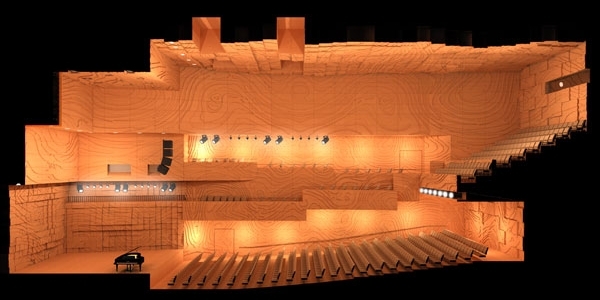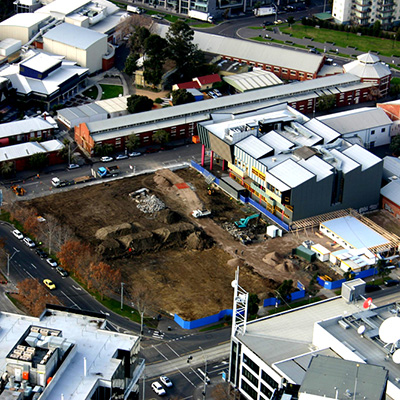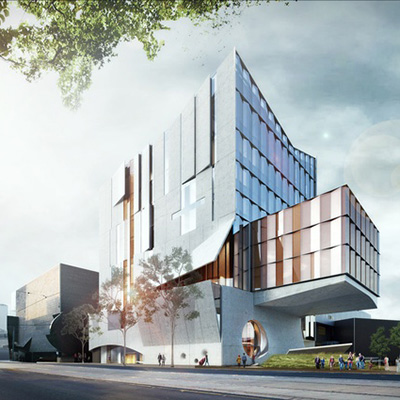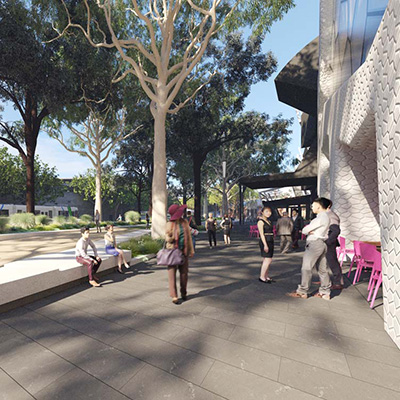THEN, NOW & NEXT: The evolution of the best place to hear (I)
Maxim Boon explores space, place and legacy as part of Melbourne Recital Centre's 10 years of great music.
Even before ground was broken on the corner of 31 Sturt Street, Ian McDougall, Founding Director of ARM Architecture, was in no doubt about the calibre of concert hall his firm had designed.

With its bold fusion of architectural whimsy, state of the art engineering and carefully calibrated acoustics, the Melbourne Recital Centre was a marvel on paper.
And yet, even with such intimate knowledge of its plans, upon first walking into the completed building in 2009, McDougall found himself awe-struck. “It was like, ‘Wow! We did this?’ It was almost disbelief that we could achieve such a thing,” he remarks. Watch more in this video

In the heart of the city
The construction of the Melbourne Recital Centre and its adjacent companion, the Southbank Theatre, represented a major addition to the already impressive collection of arts institutions on St Kilda Road, namely the Hamer Hall, the Arts Centre Melbourne and the National Gallery of Victoria. Their placement on Sturt Street also suggested a notional link between the most distant venues of Melbourne’s Arts Precinct, Malthouse Theatre and the Australian Centre for Contemporary Art, and their more prominent riverside counterparts. Now, several major developments already underway are set to truly galvanise the full portfolio of arts destinations in the heart of the city

Flanking the Southbank Theatre, Buxton Contemporary – the most recently completed addition to the area, opened in March 2018 – repurposed and modernised an existing structure to create a gallery space dedicated to championing Australian-made art. However, a series of purpose-built venues and refreshed public spaces will radically transform the blueprint of the precinct over the next six years. Immediately next door to the Centre, the finishing touches are currently being made to the Ian Potter Southbank Centre, a $105 million, state-of-the-art music conservatorium, which will serve students from both Melbourne University and the Victorian College of Art. Much like the Melbourne Recital Centre and Southbank Theatre, its architecture is fearlessly innovative. Designed by John Wardle Architects, its most striking feature is a dramatic, cantilevered 400-seat concert space, thrusting out above a new pedestrianised zone.
Vitality and visibility
Major collaborations between the new music school and the Melbourne Recital Centre are already in the works, the Centre’s Director of Artistic Planning Marshall McGuire shares. “With the wealth of fabulously talented, young music students next door, it’s creating a great opportunity for us and for them to engage in more depth, and that is sure to increase the vibrancy both institutions bring the precinct,” he says. “It’s cementing relationships we already have with the VCA in a way that creates more energy, vitality and visibility, and more opportunities to make music.”

However, the most significant upgrades to the area are part of capital works being spearheaded by the Victorian Government. On the site opposite the Centre, currently occupied by Carlton and United Breweries, a new home for the Australian Music Vault will be constructed, as well as the NGV Contemporary, which when completed will be the largest contemporary art gallery in Australia. In addition, more than 18,000 square meters of new and upgraded public space will, for the first time, offer direct access between the Melbourne Recital Centre on Sturt Street and Southbank Boulevard, one of the city’s busiest pedestrian thoroughfares. Works are due to be completed by 2025 and will generate substantially increased foot traffic around the Centre and its neighbours.
From the outside in
Given the rich architectural pedigree already established by the Melbourne Recital Centre, Southbank Theatre and Ian Potter Southbank Centre, the design for the NGV Contemporary (as yet to be unveiled) is likely to be similarly iconic. The Arts Precinct is destined to become as much a hub for architecture buffs as it is for culture seekers, and this is something McGuire and his colleagues are already taking advantage of. Venues that are outwardly fascinating offer a crucial means of attracting newcomers across the threshold, he explains. “It’s something we’ve really started to explore in the past year, with the installation of Brook Andrews Donut I. It’s biggest impact has been from outside; when you pass the building you can’t help but be intrigued. Getting people to look at the architecture, piquing their interests, making them think ‘Well, what’s going on in there?’ It’s all about making the Melbourne Recital Centre a place you want to be engaged by.”
NEXT UP, PART II:
The Evolution of the best place to hear (II): Maxim Boon on the spirit of community

ABOUT THE AUTHOR: MAXIM BOON
Maxim Boon is a British writer and composer based in Melbourne and the Chief Classical Music Critic for The Age. Formerly the Senior Editor of The Music and Online Editor of Limelight Magazine, he is also a regular contributor to The Guardian, Time Out, Sydney Morning Herald, Daily Review and Arts Hub.


